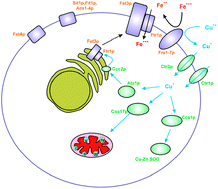Abstract
Calorie restriction (CR) is a non genetic intervention, known to confer longevity benefits across the various phyla from unicellular yeast to mammals. CR also invokes homeostatic responses similar to stress, however the sequence of molecular events leading to longevity is still illusive. In this study, we analysed the whole genome gene expression profile in response to CR, mutations mimicking CR, heat shock and H2O2 from a gene ontology perspective. Our analysis revealed that mitochondrion is a common hub in the gene expression programme under these conditions and the electron transport chain (ETC) is a major player. Consequently the genes involved in the metal ion transport were also significantly up-regulated. We confirmed the results of the in silico analysis using quantitative real time PCR which showed up-regulation of genes involved in respiration and transport of iron and copper. The promoter activity of one of the representative genes, FET3, was also found to be higher upon calorie restriction. Altogether, our results indicate that upon calorie restriction the levels of iron and copper fall in cells, which elicits a transcriptional response up-regulating the genes involved in their uptake to maintain cellular homeostasis.


 Please wait while we load your content...
Please wait while we load your content...